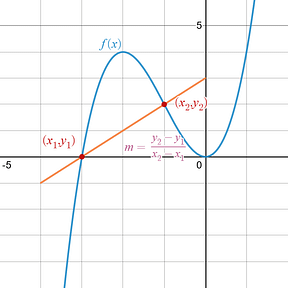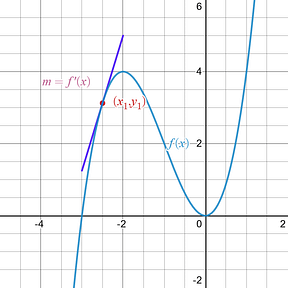Algebra vs. Calculus
It is really important that you recognize that you have done much of the work of calculus back in algebra. Calculus just extends an idea we already know, slope. Then the traditional calculus textbook freaks us out by packaging the old material, algebra, and the new material, calculus, in some very heavy math formulas.
|
Algebra |
Calculus |
|
Average rate of change= Slope between two points . |
Instantaneous rate of change = Slope at single point . |
|
Slope of a secant line, a line connecting two points, and .
You can see that this is truly an average rate of change of the function, , because the actual graph increases and decreases (changes) quite a bit between those two points, but the average change is increasing, going up. |
Slope of the tangent line, a line that touches your equation at a single point, .
You can see that the instantaneous rate of change of the function can be quite different at different moments in time, different . Here the change is going up, meaning increasing. Finding the slope of the tangent line (a line that touches the actual function at just one point, ) allows you to see what change is happening to the actual function at one instant in time, . |
|
The equation for finding the slope of the secant line or the average rate of change:
|
The equation for finding the slope of the tangent line or instantaneous rate of change: |
|
Slope means Slope No matter which rate of change you are finding you are always finding the slope of a line, the m , from your old friend . |
|
|
Equation for finding the slope between two points.
|
Equation for finding the slope between two points.
The major difference is that our , our derivative equation, will vary from to . |
|
So, if someone asks you to find: – Slope of the secant line – Average rate of change You would want to use your classic slope formula to find the value.
|
If someone asks you to find: – Slope of the tangent line – Instantaneous rate of change You would need to find the derivative, , and then use that derivative equation to find the value.
|



